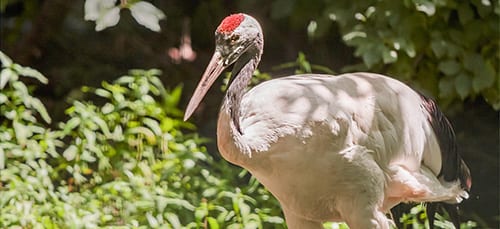Where They Hang Out
At the zoo: In an aviary on the side of Bird World
In the wild: Russia, Japan and North Korea on rocky sea coasts or mountain slopes near water
Favorite Foods
At the zoo: fish, rats, chicks, mice
In the wild: fish, smaller water birds, young seals and carrion
Social Life
Primarily lives a solitary life with the exception of mating pairs.
About Ursula
Haliaeetus pelagicus
Introducing our feathered friend, Ursula, a Steller’s sea eagle or Haliaeetus pelagicus. Just looking at Ursula’s intense stare it is easy to see why she was named after the sassy villain from the story The Little Mermaid. She is also very tough and not to be underestimated. Her keepers have a healthy respect for her boundaries.
Steller’s sea eagles nest on the coast and rivers of eastern Russia and migrate to Japan and Korea in winter. Occasionally, some individuals stay in Russia during winter if they can be near open water where they find their main food source, fish. Sometimes this species of eagle eats small birds, crab, shellfish and carrion such as dead deer or other mammals. Ursula especially likes to eat mammals like rats when she is rearing a chick. Steller’s sea eagles build a nest of twigs and sticks in trees or on rocks and lay 1-3 eggs in a clutch. Ursula’s was introduced to her mate, Vlad the Impaler, in 2012. These two typically nest build in winter. The couple has produced 2 offspring which now live at Columbus Zoo and Fort Worth Zoo. Hopefully they will continue to be successful parents.
Steller’s sea eagles are the heaviest eagle species with females weighing about 15-20 pounds and males weighing about 11-13 pounds. They have a wing span of 6-8 feet. This is a big bird but Steller’s are not the largest eagle in any measurement, but weight. Harpy eagles and Philippine eagles have a larger wingspan.
According to the IUCN Red list Steller’s sea eagles are classified as Vulnerable to extinction with less than 5000 individuals in the population. They are legally protected in all of the countries they are natively found and are even considered a national treasure in Japan. One of the proposed conservation actions is to survey the species to get a more accurate number of how many are left in the wild. Some of the numerous threats they face in the wild include habitat alteration for hydroelectric power projects and development of the petrochemical industry, logging, pollution, DDT/DDE (a banned pesticide), PCBs (a toxic industrial coolant), lead poisoning (from eating deer carrion killed by lead shot) and overfishing. Since eagles are an apex predator any toxins in the food chain are accumulated in the food until it reaches the eagle in highly intensified levels leading to many health and reproductive issues. High levels of toxins in their prey can even lead to death.
Steller’s sea eagles are easily recognized due to their size and dramatic appearance. One of the most noticeable features about Ursula is her massive yellow strongly hooked beak which matches her feet in color. Another distinguishable feature of an adult Steller’s sea eagle is the white “shoulders” and white wedge shaped tail. Ursula is very vocal and typically lets anyone know when she wants her space. She can sometimes be heard making an aggressive deep barking noise.
You can visit Ursula in the Bird of Prey habitat on the side of Bird World in between the African penguins and Toyota Elephant Passage.

